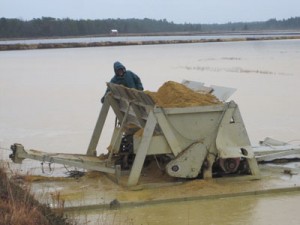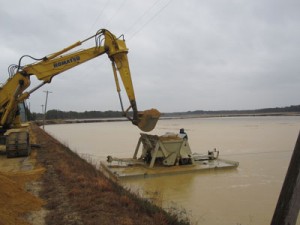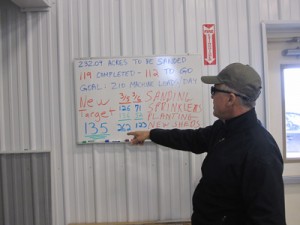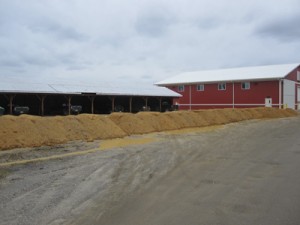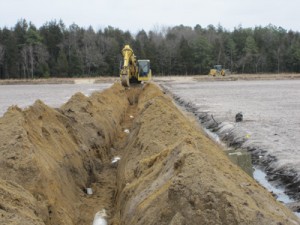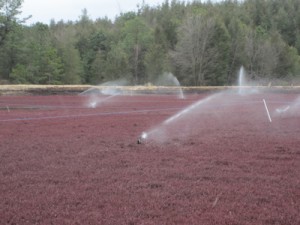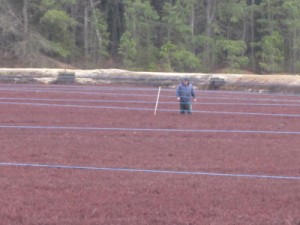One of the things CEO Bill Haines has always liked about farming is that when it’s time to do something, you do it. Unfortunately, as we have seen over the past six months or so, the weather does not always cooperate. That’s when Pine Island has to adapt plans in order to make the best decisions. At this time, our priorities are finishing up sanding, starting sprinkler installation, completing the Oswego renovation, and finishing prepping the ground for new buildings at the shop.
“We made an ambitious plan for sanding this year,” Bill says. “We usually start in January, and by the middle of February, we’re going steady. This year because of all the rain and slushy snow, the dams were so wet and sloppy that it made sanding impossible. Hauling will wreck dams, and since this has continued into March, we’re not as far along as we want to be. When we stopped to analyze, it was clear that if everything went perfectly we weren’t going to finish until March 26th…which is when we expected to start planting.” Well, that wasn’t acceptable to Bill or to our GM, Fred Torres. “You could make the case that it won’t kill us not to get it all done,” Bill says, “but the thing is, if you just add what’s left to next year’s to-do list, pretty soon it’s out of control, and you’ll never catch up.”
Bill and Fred sat down and went over some options. “You always have to have at least two plans,” Fred says. “We have a lot on our plate this month. But we do have a little bit of time to play with. We just need to look at what jobs have to get done, and then do them.”
As far as the sanding is concerned, Bill and Fred ran some numbers and decided to change things up a little. “There hasn’t been a lot of rigorous experimentation done with it; growers have just done it on the job,” Bill says. “Is an inch better than a half inch? Does it vary by variety? What’s the rotation: four years? Five? Six?” Sanding is expensive in terms of both labor and fuel. Eventually, he decided on a five year schedule. There have been ongoing experiments: “There are some Stevens bogs that haven’t been sanded in eight years that have been very productive,” Bill says. “On Ben Lears, a half-inch doesn’t seem to work very well, and we need to up it to an inch. But Early Blacks seem to thrive with half an inch.” So the new plan is to drop to a half inch of sand on the Early Blacks from this week on. It will save time, and then we can also compare results. “That’ll put us on target to finish by the 18th, weather permitting,” Bill says. “Which is much better than the 26th.”
Once this decision was made, PIICM Manager Cristina Tassone updated the paperwork, Bill communicated the changes the following morning to the entire Pine Island team, and Fred made a new plan. Equipment Supervisor Carlos Baez is taking advantage of the bad weather to service the excavator and the sander. (“If I did it at lunch time on a sanding day, it would take longer than half an hour and would hold the team up,” Carlos says.) The team is also patching the dams where necessary on the current sanding route. “You have to stay ahead,” Fred says. “Currently the weather is supposed to clear up, but if not, we’ll adapt. The patches are done, the sprinklers are done, the main line is on track…so the back up plan is to go back to cutting survey lines.”
By April 1st, the building project has to start. “As of today, the gravel is done,” Fred says. “Once it dries, we can level it and be ready to start. So ground prep is about finished.”
Other projects we’re working on during the weather-enforced delay are sprinkler installation and the new main irrigation line at the Oswego renovation. “[Bog Renovations manager] Joe Colon is working on the main line,” Fred says. “That should be done by the end of next week.”
While all of this is going on, we also have a team installing sprinklers. We remove the sprinklers before winter flood and reinstall them in the spring. The team will take the water off just long enough to put sprinklers back in and then re-flood before water comes off for good in April; this way we’ll have at least one-third to forty percent of it done before all of the water is off. “When the water comes off, they have to be ready for frost,” Bill says. “Protecting the vines from frost is our most important task in April and May.”
“We know what we have to get done, and we’re going to do whatever it takes to get that done,” Bill says. “And if that means changing gears from day to day, that’s what we’re going to do. This is why we need employees willing to be flexible and think out of the box.”

